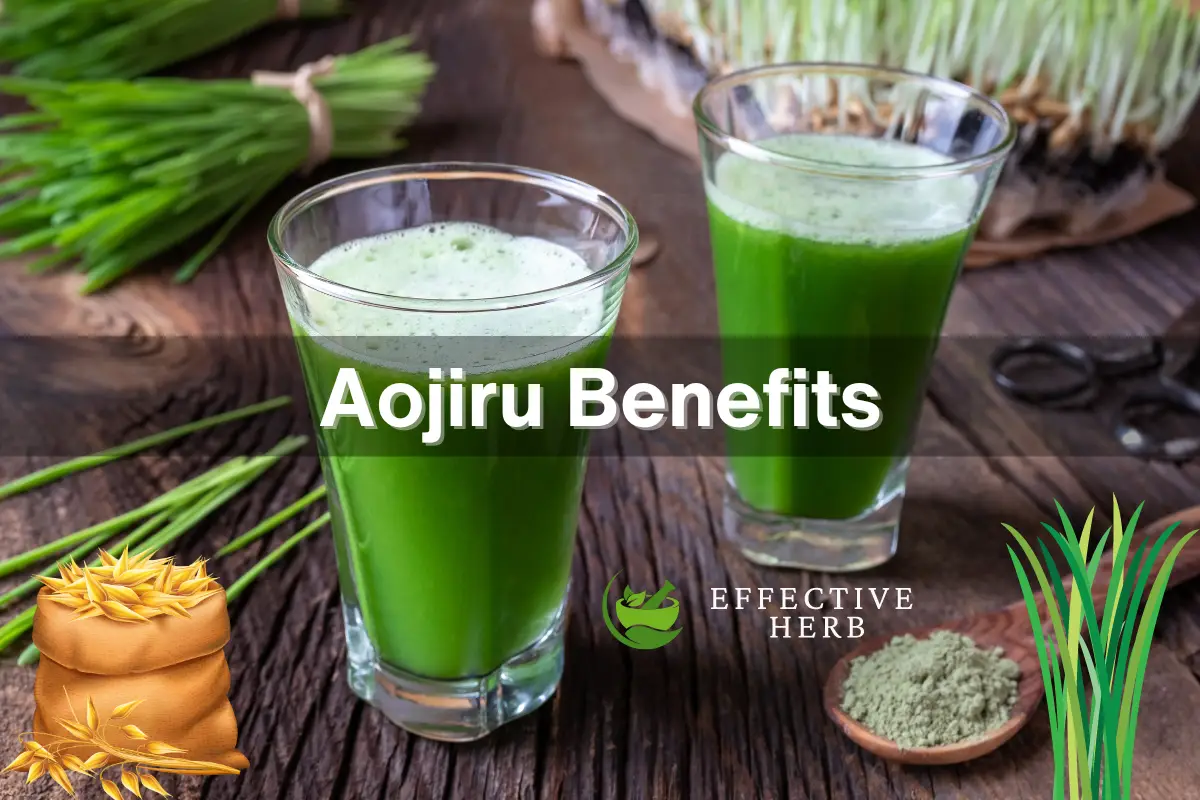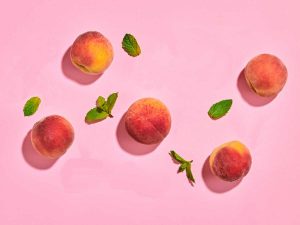Aojiru Health Benefits
Aojiru is a drink that originated in Japan and is made from young barley grass squeezing its juice. It is also known as green juice or green drink. Aojiru’s health benefits depend on concentrated bio active components like vitamins, minerals, antioxidants, and chlorophyll.
It is also known as green vegetable juice. Historically, barley grass has been the primary ingredient of the Aojiru drink. Still, modern Japanese cuisine also adds the juice of fresh green vegetables like kale, spinach, and cabbage to enhance its nutritional profile and flavor.
This vibrant green drink is often consumed for its potential to boost energy levels, support digestion, and enhance the immune system.
What is barley grass?
Barley grass refers to the young shoots of the barley plant, specifically the leaves, and stems before the plant reaches maturity. This drink is typically made from the juice of these young barley grass. The drink’s green color comes from the chlorophyll present in these fresh green barley leaves. These leaves are often juiced or powdered to make the Aojiru drink.
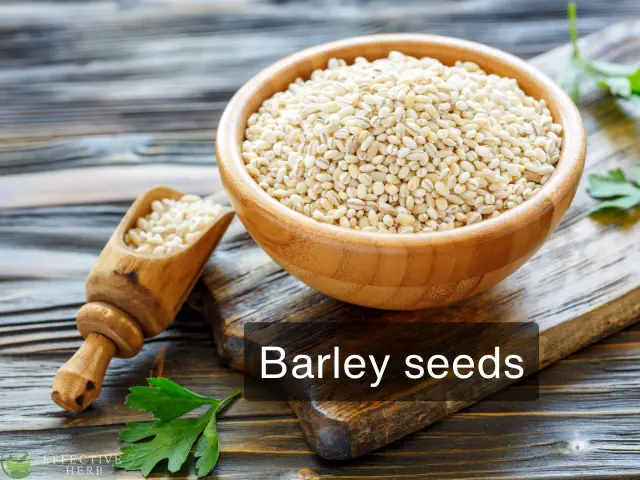
Barley (Hordeum vulgare), a member of the grass family, is a major cereal grain grown in temperate climates globally. It was one of the first cultivated grains; it was domesticated in the Fertile Crescent around 9000 BC, giving it nonshattering spikelets and making it much easier to harvest. Its use then spread throughout Eurasia by 2000 BC. Barley prefers relatively low temperatures to grow, and well-drained soil. It is relatively tolerant of drought and soil salinity, but is less winter-hardy than wheat or rye.
wikipedia.org/wiki/Barley
Taxonomy of Barley
Before discussing Aojiru’s health benefits, consider and understand the source used in the drink.
Barley (Hordeum vulgare) is a cereal grain belonging to the Poaceae grass family. Its taxonomy is as follows:
- Kingdom: Plantae
- Phylum: Angiosperms
- Class: Monocots
- Order: Poales
- Family: Poaceae
- Genus: Hordeum
- Species: Hordeum vulgare
The plant is an annual grass with erect stems, linear leaves, and flowers borne in dense spikes. Barley grains, used for food or animal feed, are rich in carbohydrates, proteins, vitamins, and minerals.
Is there any nutritional difference between Barley grass and barley matured grains?
Both young barley plants (barley grass) and barley grains contain beneficial compounds.
There are differences in their composition due to their developmental stages.
Barley Grass
Barley grass, harvested early on, is rich in chlorophyll, vitamins, minerals, antioxidants like flavonoids and phenolic compounds, enzymes, and amino acids. These nutrients are often found in higher concentrations in young shoots than mature grains.
Barley Matured Grains
Barley grains, on the other hand, are a source of fiber, carbohydrates (including both simple and complex carbohydrates), some proteins, B vitamins (like niacin, thiamine, and folate), and minerals (such as selenium, zinc, and magnesium).
So, barley grass and barley grains offer nutritional benefits, but their concentrations of specific bioactive compounds differ due to their growth stages. However, Aojiru’s health benefits can only be found in barley grass.
Aojiru Health Benefits
The health benefits of Aojiru are derived from its bioactive compounds that enhance bodily organ functions. These compounds notably improve various physical systems, highlighting the positive effects of Aojiru on health, as outlined below:
Liver Support
The chlorophyll in Aojiru aids the liver by enhancing its detoxification processes. It assists in flushing out toxins and heavy metals from the body, reducing the burden on the liver. Additionally, Aojiru’s antioxidants, including vitamins C and E, protect liver cells from oxidative damage caused by free radicals, promoting liver health and function.
Digestive System Enhancement
Enzymes in Aojiru, like amylase and lipase, aid in the breakdown of carbohydrates and fats, respectively, facilitating smoother digestion. Its high fiber content promotes gastrointestinal health by supporting regular bowel movements and fostering a diverse and healthy gut microbiome, essential for overall digestive well-being and nutrient absorption. Source.
Skin Nourishment
Aojiru’s antioxidants, such as beta-carotene, vitamin E, and flavonoids, shield the skin from oxidative stress and damage caused by free radicals. These compounds also promote collagen synthesis, improving skin elasticity and reducing the appearance of wrinkles. Chlorophyll’s anti-inflammatory properties may aid in calming skin irritations and supporting wound healing.
Immune System Boost
Its nutrient profile, vitamins C and E, and minerals like iron, zinc, and selenium fortify the immune system. Vitamin C stimulates the production of white blood cells, crucial defenders against infections. The iron and zinc play pivotal roles in immune cell function and response, collectively supporting a robust immune system.
Heart Health
Potassium, flavonoids, and polyphenols found in Aojiru contribute to heart health by regulating blood pressure, reducing the risk of hypertension, and protecting against oxidative damage to blood vessels. These compounds support cardiovascular function and reduce the risk of heart disease.
Kidney Wellness
By aiding detoxification, Aojiru helps alleviate stress on the kidneys. This may assist in reducing the risk of kidney-related issues and support overall kidney health by ensuring proper elimination of waste and toxins from the body.
Eye Protection
Lutein, zeaxanthin, and beta-carotene present in Aojiru accumulate in the retina. They protect against oxidative stress and potentially reduce the risk of age-related macular degeneration and cataracts. These compounds promote optimal eye health and vision.
Cognitive Function
Antioxidants in Aojiru, like vitamins E, C, and beta-carotene, support cognitive function by protecting brain cells from oxidative damage and inflammation. These compounds reduce the risk of cognitive decline and support overall brain health.
Bone Strength
Calcium, magnesium, and vitamin K content in Aojiru are critical in maintaining bone health. Calcium and magnesium contribute to bone density and strength, while vitamin K aids in bone mineralization. Collectively, they reduce the risk of osteoporosis and fractures.
Blood Health
Chlorophyll in Aojiru, with its similar structure to hemoglobin, potentially aids in red blood cell production, supporting better oxygen transportation and enhancing overall blood circulation.
Weight Management
Its low-calorie, nutrient-dense nature supports weight management by providing essential nutrients without contributing to excessive calorie intake. Additionally, its fiber content promotes satiety, reducing overall calorie consumption and aiding in weight control. Reference.
Anti-inflammatory Effects
Aojiru’s diverse array of antioxidants, including flavonoids, polyphenols, and other phytochemicals, counteract inflammation by neutralizing free radicals and reducing the production of inflammatory compounds.
Energy Boost
B vitamins, especially B6 and B12, found in Aojiru, participate in energy metabolism, converting food into energy and supporting mitochondrial function. This helps increase energy levels and combat fatigue.
Hormonal Balance
Phytoestrogens present in Aojiru help maintain hormonal balance, potentially reducing the risk of hormone-related issues and supporting overall hormonal health in both men and women.
Cellular Health
The rich antioxidant profile of Aojiru shields cells from damage caused by free radicals. It promotes cellular health and potentially reduces the risk of various diseases associated with oxidative stress.
Longevity
By supporting multiple organs and bodily systems, Aojiru contributes to overall health improvement.
Incorporating Aojiru into one’s daily routine offers comprehensive health benefits, including supporting various bodily functions and contributing to overall well-being. Aojiru’s health benefits encompass improved digestion, boosted immunity, detoxification, and increased energy levels, making it a valuable addition to a healthy lifestyle.
Aojiru’s Nutrients
Here’s a breakdown of nutrients commonly found in Aojiru (green juice):
- Vitamins: Aojiru typically contains vitamins A, C, E, and K, along with B-complex vitamins like B1, B2, B6, and B12.
- Minerals: It often includes minerals such as calcium, magnesium, potassium, iron, and zinc.
- Chlorophyll: A key component due to its green color, chlorophyll offers potential antioxidant and detoxification benefits.Fibrer: Aojiru may contain dietary fiber, aiding digestion and promoting gut health.
- Enzymes: Some varieties contain enzymes like protease and lipase that assist digestion.
- Amino Acids: These are the building blocks of proteins, and Aojiru can contain various essential and non-essential amino acids.
- Polyphenols: These antioxidants can support overall health and potentially reduce inflammation.
- Carotenoids: These compounds contribute to the drink’s color and may offer antioxidant properties.
- Flavonoids: Often present in Aojiru, these compounds have antioxidant and anti-inflammatory effects.
- Phytochemicals: Various plant-derived compounds are present, potentially providing health benefits.
- Alkaloids: Some Aojiru drinks may contain alkaloids like caffeine or theanine from green tea leaves.
- Omega-3 fatty acids: Certain Aojiru varieties with added ingredients may contain these beneficial fatty acids.
- Probiotics: Some versions include probiotics for gut health, promoting a balanced microbiome.
- Prebiotics: Certain Aojiru blends might contain prebiotic fibers to support the growth of beneficial gut bacteria.
- Antioxidants: Overall, Aojiru is rich in antioxidants, helping to combat oxidative stress in the body.
- Phosphorus: This mineral contributes to bone health, energy production, and cell repair.
- Sulfur: Aojiru might contain sulfur, which is vital for various biological processes, including enzyme function.
- Copper: Essential for producing red blood cells and maintaining healthy connective tissues.
- Manganese: Helps in bone formation, metabolism, and antioxidant defense.
- Selenium is a trace mineral with antioxidant properties supporting the immune system and thyroid function.
- Iodine: Some formulations may include iodine, which is crucial for thyroid hormone production.
- Silicon: Plays a role in bone health, connective tissue, and collagen formation.
- Betaine: Found in some Aojiru blends, betaine can support liver function and cellular health.
- Lutein and Zeaxanthin: These carotenoids promote eye health and may reduce the risk of age-related macular degeneration.
- Tannins: Polyphenolic compounds that may offer antibacterial and antiviral properties.
- Essential Fatty Acids: Besides omega-3s, Aojiru might contain other essential fatty acids like omega-6s.
Remember, the specific nutrient profile can vary depending on the ingredients used in the particular Aojiru formulation.
Preparation of Aojiru Drink
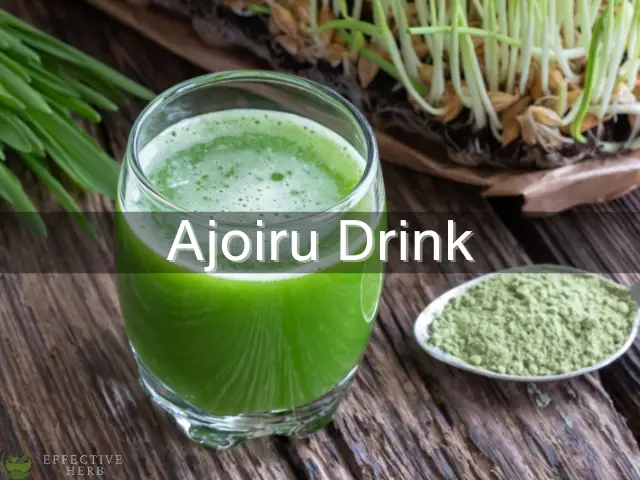
Harvesting: Barley grass is typically harvested when it’s young and tender, usually around 7-14 days after sprouting.
Processing
The harvested grass is cleaned, juiced, and dried using air or freeze-drying methods to retain nutrients.
Powder Production
The dried juice is ground into a fine powder, which is often the form sold to consumers.
Consumption
The powder is mixed with water or other liquids to make the Aojiru drink.
Additives
The acquired liquid is then added. The juices of one or more vegetables or other ingredients, like citrus fruits, ginger, honey, etc., are added to the acquired liquid to enhance the flavor and nutrient value of Aojiru.
Additives To Aojiru
There are several ingredients commonly used to enhance flavors to increase health benefits. Some of them have been listed here:
- Citrus Fruits: Lemon or lime juice can add a refreshing tanginess.
- Ginger: Adds a spicy kick and aids digestion.
- Honey or Agave: Sweeteners that complement the grassy taste.
- Mint Leaves: Provides a fresh and cooling flavor.
- Pineapple or Apple: Adds natural sweetness and balances the earthy taste.
- Cucumber: Offers a mild, refreshing flavor.
- Chia Seeds or Flaxseeds: Boosts nutritional content and adds a slightly nutty taste.
- Umeboshi Plum Paste: Provides a tangy, salty taste that contrasts the grassy flavor.
- Soy Milk: Adds creaminess and a hint of nuttiness.
- Sesame Seeds or Sesame Oil: Offers a toasty, nutty flavor.
- Shiso Leaves: Imparts a unique, herbaceous taste that complements the grassy notes.
- Powdered Sencha: Another type of green tea powder that can be used for a different tea-like taste.
- Silken Tofu: Creates a smooth texture and adds protein.
- Matcha Powder: Adds a stronger green tea flavor and boosts antioxidant content.
These additives can be used individually or in combinations to customize the taste and nutritional profile of Aojiru according to personal preferences. So additives are beneficial to enhance Aojiru’s health benefits.
Aojiru Dosage Guide
The recommended intake generally ranges from one to two teaspoons of Aojiru powder, which is roughly equal to 3-6 grams, mixed with water or a preferred beverage, to be consumed once a day.
However, it’s essential to note that individual tolerances and product concentrations may vary, so starting with a smaller amount and gradually increasing it can be beneficial to gauge personal response.
Always adhere to the guidelines provided on the product packaging or the advice of a healthcare professional for personalized recommendations for safe and optimal consumption.
How to prepare barley tea?
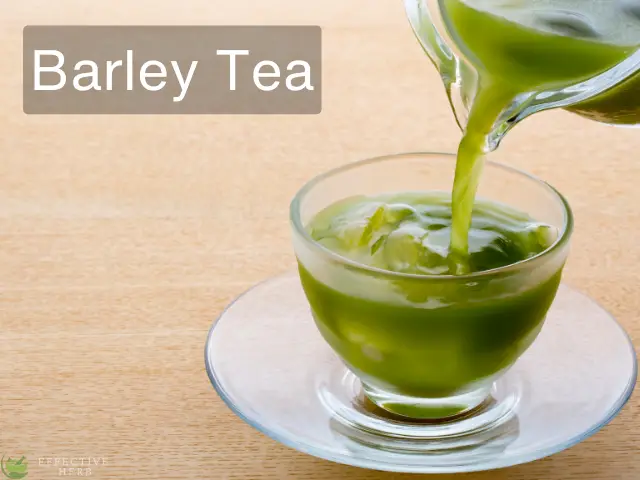
Here’s a comprehensive guide on how to prepare barley tea using various steps:
Ingredients
- Barley: 1 cup of roasted barley grains
- Water: 6-8 cups of water
Equipment
- Pot or Kettle: for boiling water
- Strainer: to strain the tea
- Pitcher or Jug: to store the tea
Steps
- Selecting Barley: Choose roasted barley grains, commonly available in most Asian grocery stores.
- Washing the Barley
- Rinse the barley grains under cold water to remove any dust or impurities.
- You can skip this step if the barley is pre-cleaned.
- Boiling Water
- Pour 6-8 cups of water into a pot or Kettle.
- Boil the water well.
- Adding Barley
- Once the water boils, add the washed barley grains to the boiling water.
- Boiling Barley
- Allow the barley and water to boil together for about 5 minutes.
- Simmering
- Reduce the heat to low and let the barley simmer for 15-20 minutes, allowing the flavors to infuse.
- Removing from Heat
- Turn off the stove and let the mixture cool down for some time.
- Straining
- Use a fine mesh strainer or cheesecloth to strain the barley grains from the tea.
- Pour the tea into a pitcher or jug.
- Serving
- Serve the barley tea hot or let it cool to room temperature before refrigerating it for a refreshing, cold drink.
- Optionally, add sweeteners like honey or sugar if desired.
Tips
- Roasting Barley: If you have raw barley, roast it in a dry pan until it turns slightly brown and emits a nutty aroma before using it for the tea.
- Variations: You can experiment with the strength of the tea by adjusting the amount of barley or steeping time.
- Storage: Store the brewed barley tea in the refrigerator for up to a week.
Enjoy your homemade barley tea!
Bottom Lines
Aojiru, a green drink prepared from young barley grass, offers numerous health benefits. It differs nutritionally from mature barley grains. Preparation involves harvesting, juicing, and powdering. The drink aids the liver, digestion, skin, immunity, heart, kidney, and eye health.

